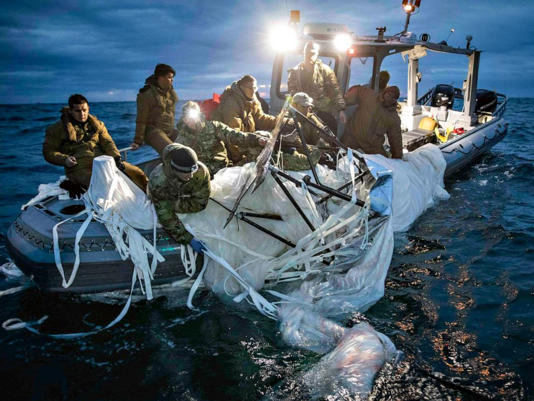📍ATLANTIC OCEAN – @USNavy Sailors assigned to Explosive Ordnance Disposal Group 2 recover a high-altitude surveillance balloon off the coast of Myrtle Beach, South Carolina, Feb. 5, 2023. pic.twitter.com/QwjSFQEw1b
— U.S. Fleet Forces (@USFleetForces) February 7, 2023
The U.S. Navy has released the first close-up photos of operations to recover parts of the Chinese surveillance balloon shot down on Saturday.
“EODGRU 2 is a critical part of the Navy Expeditionary Combat Force that clears explosive hazards to provide access to denied areas; secures the undersea domain for freedom of movement; builds and fosters relationships with trusted partners, and protects the homeland,” according to the U.S. Fleet Forces Command post.
Air Force Gen. Glen D. VanHerck, the commander of the North American Aerospace Defense (NORAD) Command and U.S. Northern Command, provided an update on Monday, stating the debris field that is about 15 football fields long and wide.
He said that precautions are being taken in case there are any explosives or toxic substances present in the balloon.
VanHerck added that the recovery operations focus is on the heavier parts of the balloon that are at the bottom of the ocean. He estimated that the balloon was up to 200 feet tall and weighed about 2,000 pounds.
The balloon was first spotted over Alaska on Jan. 28, according to the Department of Defense, and then made its way across the United States before it was shot down Saturday afternoon by an F-22 Raptor fighter over the Atlantic Ocean.
China has insisted that the balloon was a civilian airship that was used for meteorological research and had gone off course due to winds and had limited “self-steering” capabilities.
The balloon recovery ops are giving folks in Myrtle Beach SC a rare look at what their military can do. Here LCAC86, an air-cushioned landing craft, came ashore at MB and drew quite a crowd. Musta seemed sorta like a spaceship when it rose up and took off https://t.co/YMILi72Qji
— Chris Cavas (@CavasShips) February 10, 2023
LOOK: Officials have released more photos of the suspected Chinese spy balloon recovery off of the Myrtle Beach coast. FULL GALLERY: https://t.co/EPwTk2tQKu
— WBTW News13 (@WBTWNews13) February 10, 2023
Photos: US Navy pic.twitter.com/k5xqQHjKSL
It wasn’t a weather balloon
The Chinese balloon that was destroyed off the coast of South Carolina was built for spying and had sophisticated communications equipment, U.S. officials said, based on information about the balloon gathered by a U-2 spy plane. It was equipped with large solar panels capable of powering a variety of intelligence-gathering sensors.
The Chinese balloon had ‘multiple antennas’ for intelligence gathering and was part of a fleet used in more than 40 countries, the US state department said. These balloons have flown over more than 40 countries and five continents “conducting signals intelligence collection operations” said the State Department.
“High-resolution imagery from U-2 flybys revealed that the high-altitude balloon was capable of conducting signals intelligence collection operations,” a senior State Department official told reporters. “The high-altitude balloon’s equipment was clearly for intelligence surveillance and inconsistent with the equipment on board weather balloons.”
"The incident, which occurred in the last two days, marked one of the most aggressive Chinese intelligence gathering maneuvers in recent years." https://t.co/xbQ6ThdxPe
— Collin Koh 🇸🇬🇺🇦 (@CollinSLKoh) February 2, 2023

